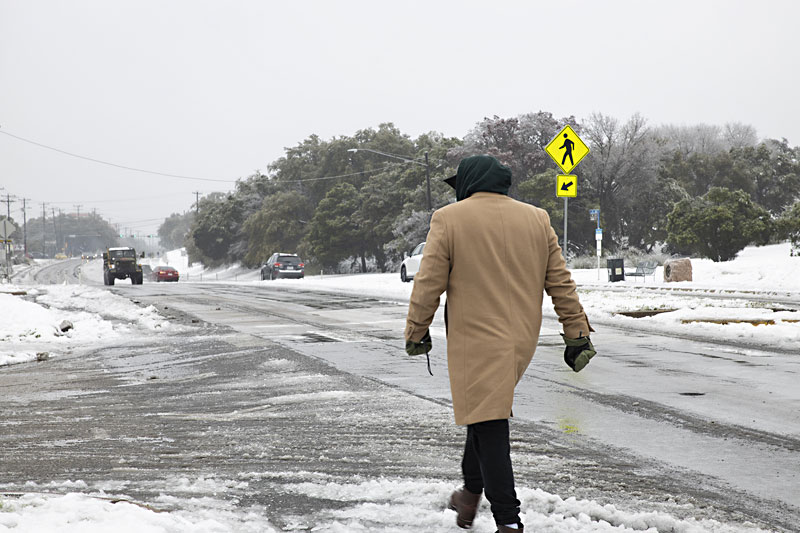East Austin Residents Need Resilience Hubs Sooner Rather Than Later
City looks to fill in some of the gaps of inequity during times of crisis
By Heather Stewart, Fri., April 29, 2022

When the power went out last year during Winter Storm Uri, people sheltered at Mendez Middle School struggled with addiction withdrawal, waited hours for food, and didn't have access to their medications, said Frances Acuña, Go Austin/Vamos Austin's climate resilience lead organizer.
"Downtown you can see case managers and case workers," Acuña said. "You see food, water, and snacks. You see mental health assistance. You see everything that is needed to have holistic care. And here, we didn't have anything."
It was three days before they received substantial help, Acuña said. Physical facilities deemed as resilience hubs could potentially fill in some of the gaps of inequity. The hubs would function out of existing city, county, and school properties and would serve as resource centers for lower-income Austinites and communities of color, said Marc Coudert of the city's Office of Sustainability.
Coudert told the Community Development Commission in February that the city is still in the planning phase for resilience hubs, but that it plans to use the $3 million earmarked for hubs by December 2024 and also seek further funding. While city leaders have high hopes, advocates who work directly with low-income residents are wary.
Austin shelters housed hundreds of residents during Uri according to the city of Austin and Travis County's after-action report; some of the shelters experienced infrastructure failure, staffing issues, and a lack of sufficient feeding services and health care. In response to these findings, City Council allocated $3 million for the hubs from its American Rescue Plan Act COVID-19 relief funds, Coudert said.
The city is working with the LBJ School of Public Affairs to compile metrics on climate impact, unemployment rates, and other relevant statistics to determine Austin's most socially vulnerable communities that would benefit most from resilience hubs, Coudert said in an interview. City officials haven't addressed what to do for vulnerable communities that don't have any preexisting buildings within safe walking distance, he added. Instead, they discussed plans to automatically make city buildings into resilience hubs from the start as well as possible transportation solutions.
Acuña said it's impossible for some Onion Creek residents to walk almost 2 miles on ill-kept sidewalks to the Mendez Middle School, the nearest potential resilience hub, in the event driving is not an option. During extreme weather conditions, residents trying to make this trip by foot could be exposed to life-threatening situations, she said.
The city plans on mirroring GAVA's climate navigator program, Coudert said. Stipend-paid neighborhood block leaders would keep communities informed throughout the year and assist homebound individuals who need alternate transportation to nearby resilience hubs.
"One role that these resiliency hubs could play is to be like a one-stop shop to get connected with city services," said Raul Alvarez, chair of the East Austin Conservancy. "Not just when there's a power outage or a freeze, but also, for example, when people need one-time help paying the rent or utilities."
Three types of resilience hubs will meet different levels of need, said Coudert. Small gathering hubs will serve as passive resource and cooling/warming centers with limited water and snacks; relief hubs will be larger, well-stocked resource centers; and grid-independent hubs will be 24-hour shelter-capable centers, though they won't always be activated.
United Way employee Elizabeth Jane said she wants resilience hubs to provide assistance with government paperwork and processes that residents would otherwise be left to figure out on their own. While taking calls during Uri for the 211 hotline – which Texas residents can call to get food, health, and housing assistance – Jane said she talked to someone seeking shelter who got out of work at 9pm but had to be at the shelter intake by 6pm.
"They like to set these expectations for people, and it's unattainable," Jane said. "That goes for all the social services. There's so many hoops people have to jump through." And if they don't, she said, "they can't get help."
Coudert said the city has been discussing the development of resilience hubs for five or six years. However, it wasn't until April 2021 that Council passed a resolution to start the process. "We wanted it yesterday and not a few months or years from now," Alvarez said. "You never know when the next crisis is going to hit. Are we just gonna relive the same problems and same nightmare every time, or are we going to learn and put a system in place that's going to better serve the community and hence save people's lives?"
Got something to say on the subject? Send a letter to the editor.






